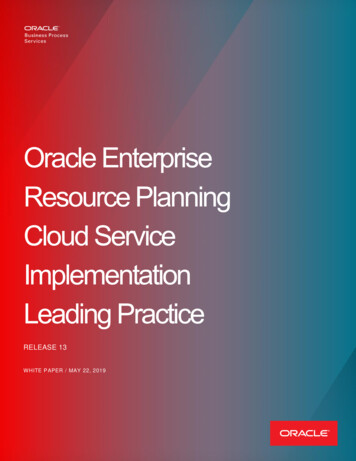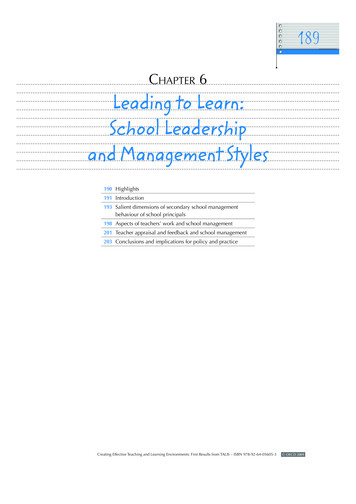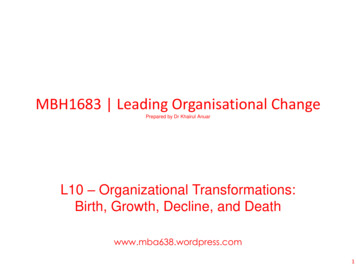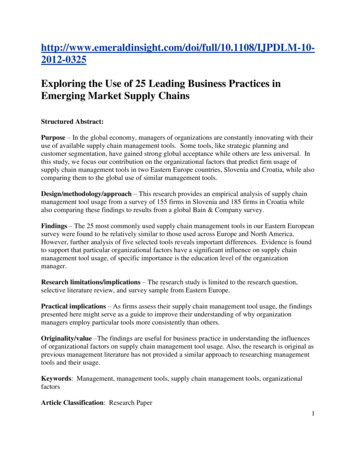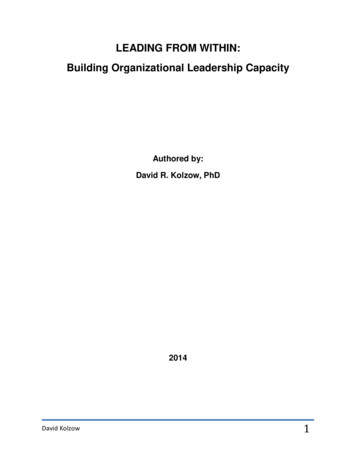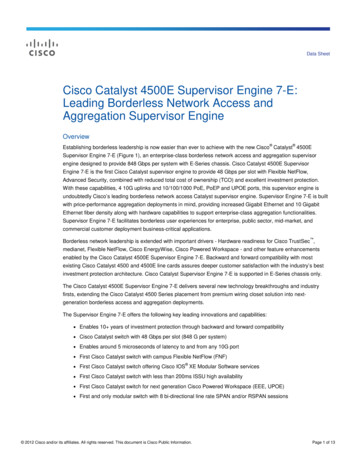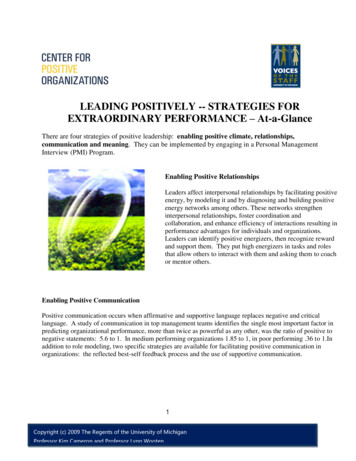
Transcription
SteLEADING POSITIVELYp -- STRATEGIES FORhEXTRAORDINARY PERFORMANCE– At-a-GlanceeThere are four strategies of positive leadership: enablingn positive climate, relationships,communication and meaning. They can be implemented by engaging in a Personal ManagementInterview (PMI) Program.M.Enabling Positive RelationshipsRLeaders oaffect interpersonal relationships by facilitating positiveenergy, bys modeling it and by diagnosing and building positiveenergy networksamong others. These networks strengthensinterpersonal relationships, foster coordination andScollaboration, and enhance efficiency of interactions resulting inc advantages for individuals and organizations.performanceLeaders hcan identify positive energizers, then recognize rewardand supporto them. They put high energizers in tasks and rolesthat allowo others to interact with them and asking them to coachor mentor others.lofEnabling Positive CommunicationBPositive communication occurs when affirmative and supportive language replaces negative and criticalu teams identifies the single most important factor inlanguage. A study of communication in top managementsas powerful as any other, was the ratio of positive topredicting organizational performance, more than twicenegative statements: 5.6 to 1. In medium performing organizations1.85 to 1, in poor performing .36 to 1.Iniaddition to role modeling, two specific strategies are availableforfacilitatingpositive communication innorganizations: the reflected best-self feedback process and the use of supportive communication.essUni1veCopyright (c) 2009 The Regents of the University of Michigan rProfessor Kim Cameron and Professor Lynn Wootensi
The reflected best-self feedback process is based on the impact of positive feedback on individualimprovement. Positive information is captured that uncovers and highlights an individual’s talents andhighest capabilities. The result is a personal agenda for capitalizing positive attributes that are notnecessarily obvious.Additional benefits of best-self feedback are strengthened relationships with feedback givers. Best-selffeedback results in higher cohesion and mutual support. (Refer to the Reflected Best Self upportive communication builds and strengthens relationships even when behavior must be corrected ornegative feedback must be provided. There are at least eight techniques; the first three are critical:Congruent: Maintain congruence among words, thoughts and feelings (authentic and sincere)Descriptive: remain objective non-evaluative (judgmental or labeling) and problem- not personfocused;Validating - communicating that the other’s perspective is worthwhileConjunctive - connected directly to the preceding messageSpecific – refer to an actual example or behaviorOwned statement– take personal responsibility for the messageDemonstrate active listening and use appropriate response types – reflective, probing, deflecting, andadvising.Enabling Positive MeaningWhen people feel that they are pursuing a profound purpose or engaging in work that is personally important,stress, depression, turnover, absenteeism, dissatisfaction are reduced; commitment, effort, engagement,empowerment, happiness satisfaction, and fulfillment are increased.Attributes of Positive meaningHas a positive impact on the wellbeing ofhumanityAssociated with an important virtue orvalueHas a long term impact or creates a rippleeffectBuilds supportive relationships or sense ofcommunityPositive Leadership StrategiesHelp workers see the effects of their work on others,give them opportunities to directly interact with clientsand to receive feedbackHighlight connections between what is meaningful toindividuals and benefits produced by the organizationHelp people see that they are creating a legacyReinforce and sponsor contribution goals rather thanself interest goalsPeople who define their work as a job work for material rewards. People who define their work as a careerare motivated by success. People who consider their work as a calling work for the sake of the work and seeka greater good. The same work may be viewed as a job or a calling depending on the individual’s perspective.Use a Tailored PMI Program to Implement the Four Strategies2Copyright (c) 2009 The Regents of the University of MichiganProfessor Kim Cameron and Professor Lynn Wooten
Implement these four strategies through a tailored PMI program. The four strategies have amplifying effectson one another. Diagnose current practice, then plan specific implementation actions. Research has shownthat implementing a PMI can significantly improve morale, trust and engagement (subjective factors) as wellas productivity and goal accomplishment (objective factors). Research has also shown that time savings isamong the benefits of PMIs. On average, leaders free up almost a day per month of discretionary timebecause of reduced interruptions, unscheduled meetings, mistakes, and problem-solving time. It increasesalignment, collaboration, improvement strategies and positive energy.PMI has two components:Conduct a role negotiation session – clarify expectations, responsibilities, evaluation standards, reportingrelationships, culture and values. This gives people a clear idea of precisely what is expected and on whatbasis they will be evaluated.Hold regular ongoing private face-to-face meetings between the leader and direct reports (or peer-to-peer orrepresentatives). There are two purposes: provide leaders with the opportunity to coach and developsubordinates and to help them improve their own skills or job performance. They also present an opportunityto demonstrate and reinforce behaviors that enable positive climates, communication, relationships andmeaning.Allow sufficient time (45-60 minutes) to accomplish specific objectives. Generate action steps focused onperformance improvement and relationship building. It is an opportunity to communicate freely, openly, andcollaboratively. Agenda items include leadership and organizational issues; information sharing;interpersonal issues; obstacles to improvement; training in necessary skills; individual needs; feedback on jobperformance and personal capabilities; resource needs; accountability for previous commitments, targets andgoals; personal concerns. Outcomes are agreements to specific actions and accountability that will bemaintained.Goals: A Key to High PerformancePMIs offer an opportunity to set and achieve difficult, difficult SMART and even Everest Goals. SMARTgoals are specific, measurable, aligned (or achievable), realistic (or reachable) and time bound. AnEverest goal goes beyond SMART goal setting, It represents an ultimate achievement, an extraordinaryaccomplishment, or a positively deviant outcome. Performance is lowest if easy goals are set. It is alsolow if no goals are set or they are too general. Performance rises if difficult goals are set, particularlydifficult SMART goals or Everest goals.3Copyright (c) 2009 The Regents of the University of MichiganProfessor Kim Cameron and Professor Lynn Wooten
An Everest Goal is SMART, but it also possess five additional characteristics:It represents positive deviance, or a focus on abundance gaps rather thandeficit gaps, and virtuousness as the desired outcome.It represents "goods of first intent," meaning that it possesses inherent value.The outcomes are sufficient and are not a means to obtain another end.It possesses an affirmative bias in that it focuses on strengths, positivephenomena, and opportunities rather than problem solving, weaknesses, orobstacles.It represents a contribution rather than merely a personal achievement, thecreation of value rather than a focus on personal pay-back, and it unleashesthe best of the human condition rather than focusing on personal benefit.It creates and fosters sustainable positive energy. It is engaging and requiresno external motivator for its pursuit.4Copyright (c) 2009 The Regents of the University of MichiganProfessor Kim Cameron and Professor Lynn Wooten
Positive Leadership Principles & PracticesPrinciplesPracticesFoster apositive workclimateCompassion: notice pain; share information; express care and concern; organize systematicaction to enable appropriate compassionate responsesForgiveness: acknowledge the hurt, identify an optimistic purpose, maintain highexpectations and standards, provide support for the harmed, let go of grudges, legitimizelanguage that elevates thought and communicates virtuousnessFrequent and public expressions of gratitude: encourage gratitude journals, letters andnotes; conduct gratitude visitsModel positive energy; provide opportunities for serving others.Develop and manage positive energy networks in stages: identify positive energizers andenable them to infect the organization through positive-energy networks, teams, andmentoring relations.Capitalize on employees’ strengths: Spend time with strongest performers; provideopportunities for employees to do what they do best; frequently celebrate positiveoutcomes; focus on what they do well to help them achieve excellence in performance andin relationships. address weaknesses to build competence.Manage negative energizers in stages.Habitually use supportive communication and encourage employees to engage insupportive communication; provide 5 positives for every negative piece of feedback, usedescriptive statements in providing negative feedback, remain problem- not person-focusedin providing negative feedbackCollect reflected best-self feedback. Obtain information from associates on unique personalcontributions, help others develop a best-self portrait, use strength recognition cardsHelp workers see the effects of their work on others, give them opportunities to directlyinteract with clients and to receive feedbackHighlight connections between what is meaningful to individuals and benefits produced bythe organizationClarify the long-term effects of what is being accomplished; help people see that they arecreating a legacyReinforce and sponsor contribution goals rather than self-interest and achievement goalsFoster positiverelationshipsamongmembersFoster positivecommunicationAssociate workwith positivemeaningReferenceKim Cameron, Positive Leadership, Berrett-Koehler (2008).5Copyright (c) 2009 The Regents of the University of MichiganProfessor Kim Cameron and Professor Lynn Wooten
Attributes of Positive meaning Positive Leadership Strategies Has a positive impact on the wellbeing of . It represents a contribution rather than merely a personal achievement, the creation of value rather than a focus on personal pay-back, and it unleashes . action to enable appropriate

